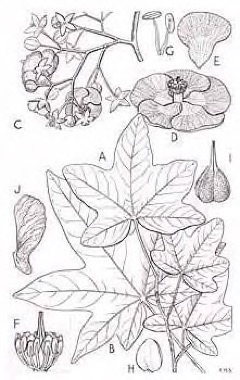 |
|
http://www.edibleplants.org |
 |
| Philipp Zinger wikimedia.org |
Translate this page:
Summary
Triplochiton scleroxylon, or commonly known as African Whitewood, is a large, tropical, deciduous tree about 65 m in height and 150 cm in trunk diameter, with large buttresses and straight trunk covered with dark gray, smooth bark. The leaves have lobes arranged like fingers on a hand. The flowers are saucer-shaped and hairy with white petals but reddish-purple at the base. The fruits have wings. The plant is used in traditional medicine for edemas and as a painkiller medicine. The leaves are edible, usually cooked as a vegetable. The trees are also planted as shade trees in cocoa plantations. A natural pioneer species, T. scleroxylon is also used in reforestation projects. The bark of the tree is used to cover the roof and walls of huts. The wood is very light in weight and soft, not durable, and susceptible to attacks of fungi termites, and dry-wood borers. It is used for interior joinery, panelling, moulding, furniture, boxes and crates, sculptures, plywood, posts, etc. Wood pulp, on the other hand, are made into paper. Plants are grown from seeds.
Physical Characteristics

 Triplochiton scleroxylon is a deciduous Tree growing to 40 m (131ft) by 25 m (82ft) at a fast rate.
Triplochiton scleroxylon is a deciduous Tree growing to 40 m (131ft) by 25 m (82ft) at a fast rate.
See above for USDA hardiness. It is hardy to UK zone 10.
Suitable for: light (sandy), medium (loamy) and heavy (clay) soils and prefers well-drained soil. Suitable pH: mildly acid, neutral and basic (mildly alkaline) soils. It cannot grow in the shade. It prefers moist soil.
UK Hardiness Map
US Hardiness Map
Synonyms
Samba scleroxylon (K.Schum.) Roberty
Plant Habitats
Edible Uses
Edible Parts: Leaves
Edible Uses:
Leaves - cooked[299 ]. They are used as a cooked vegetable or sauce in traditional cuisine in west Africa[299 , 617 ].
References More on Edible Uses
Medicinal Uses
Plants For A Future can not take any responsibility for any adverse effects from the use of plants. Always seek advice from a professional before using a plant medicinally.
Analgesic
The plant is used in traditional medicine to treat oedemas and as an anodyne[299 ].
References More on Medicinal Uses
The Bookshop: Edible Plant Books
Our Latest books on Perennial Plants For Food Forests and Permaculture Gardens in paperback or digital formats.

Edible Tropical Plants
Food Forest Plants for Hotter Conditions: 250+ Plants For Tropical Food Forests & Permaculture Gardens.
More

Edible Temperate Plants
Plants for Your Food Forest: 500 Plants for Temperate Food Forests & Permaculture Gardens.
More

More Books
PFAF have eight books available in paperback and digital formats. Browse the shop for more information.
Shop Now
Other Uses
Paper Pioneer Roofing Wood
Agroforestry Uses: The trees are often preserved in cocoa plantations to serve as shade trees[299 ]. In Nigeria Triplochiton scleroxylon is planted in agroforestry systems with cocoa[299 ]. The plant is a natural pioneer species, rapidly invading open land in situations such as abandoned farm land. It could be used to help re-establish native forest or as a nurse tree in establishing a woodland garden[299 , K ]. Other Uses The bark is used to cover the roof and walls of huts[299 ]. The heartwood is whitish to pale yellow; it is indistinctly demarcated from the up to 15cm wide band of somewhat lighter sapwood. The grain is usually interlocked, sometimes straight; texture is moderately coarse. The wood has a ribbon-like aspect on quarter-sawn faces, and is lustrous. Fresh wood has an unpleasant smell, which disappears upon drying. The wood is very light in weight; very soft; not durable, being liable to fungal attack (e.g. blue stain), and susceptible to termites, powder-post beetles and dry-wood borers - it should not be used in contact with the ground or exposed to the weather. It seasons rapidly with little risk of checking or distortion; once dry it is moderately stable to stable in service. It works easily with hand and machine tools; ordinary saw teeth and cutting tools can be used; sharp edges are needed for a smooth finish, and the wood tends to tear in mortising - a cutting angle of 15? is recommended when planing to prevent tearing; peeling and slicing properties are good; the wood stains and polishes well; filling is recommended to obtain a good finish; nailing and screwing properties are rather poor; splitting may occur; gluing does not cause problems, although it must be done carefully as the wood is absorbent. The carving characteristics are good. The wood is widely used for interior joinery, panelling, moulding, furniture, boxes and crates, sculptures, matches, pencils, peeled and sliced veneer for interior and exterior parts of plywood, fibre and particle boards, and block board. It is of great importance for house building, for beams, posts and planks, and is also used for roof shingles. The wood from the buttresses is used to make doors, platters, bowls and sandals, and the bole is used for dugout canoes. The wood pulp can be used to produce paper of moderate quality[299 , 848 ].
Special Uses
Food Forest
References More on Other Uses
Cultivation details
A plant of the moist, lowland tropics, where it is found at elevations up to 900 metres. It grows best in areas where annual daytime temperatures are within the range 24 - 30°c, but can tolerate 18 - 36°c[418 ]. It prefers a mean annual rainfall in the range 1,600 - 2,400mm, but tolerates 1,000 - 4,000mm[418 ]. Requires a sunny position[418 ]. Succeeds in most well-drained, fertile soils[418 ]. Prefers a pH in the range 5.5 - 6.5, tolerating 4.5 - 7.5[418 ]. A very fast-growing tree. Under natural conditions seedlings may reach 15 metres tall and 15cm in stem diameter after 4 years. Mean annual diameter increment in the forest averages 1cm, but in Nigeria mean annual diameter increments of up to 2.5cm have been recorded and in the Central African Republic as low as 0.3cm. In a 19-year-old plantation in Ghana with 600 stems/ha, the trees were on average 21.8 metres tall with a bole diameter of 27cm[299 ].
References Carbon Farming Information and Carbon Sequestration Information
Temperature Converter
Type a value in the Celsius field to convert the value to Fahrenheit:
Fahrenheit:
The PFAF Bookshop
Plants For A Future have a number of books available in paperback and digital form. Book titles include Edible Plants, Edible Perennials, Edible Trees,Edible Shrubs, Woodland Gardening, and Temperate Food Forest Plants. Our new book is Food Forest Plants For Hotter Conditions (Tropical and Sub-Tropical).
Shop Now
Plant Propagation
Seed - it starts to germinate 1 - 2 weeks after sowing, but the germination rate is often low. Germination rate and speed increase when the seeds are pre-treated by moistening between layers of damp cotton wool[299 ]. Fruits with wings removed are shallowly buried in pots, which are placed under shade. The seedlings are pricked out when first leaves appear. They are fragile and sensitive to damping off[299 ]. They develop a taproot, which is often forked, with few lateral roots in the upper 15cm of the soil. The taproot of a 2 metre tall sapling may be 1 metre long[299 ]. Seedlings of 1 - 3 years old with their tops intact but the root system severely cut back to permit planting in 40 cm x 40 cm x 40 cm holes were successful[299 ]. However, it has also been observed that cutting the primary root for planting causes serious drawbacks; new roots form slowly, which makes the plant liable to parasitic attacks[299 ]. The fruits can be collected from the trees when still green just before maturation. Fruits stored at 18°c fully retained their viability for 18 months. However, at 25°c viability drops from about 80% to 15% after 6 months[299 ]. More than 50% of the seeds may still germinate after being stored for 7.5 years in sealed containers at 4?c[299 ]. Single-node cuttings with one leaf were rooted successfully under mist; rooting was improved by a hormone dip and a high temperature in the bed (30°c)[299 ]. Cuttings 10cm long with 2 - 4 leaves taken from 2 month-old branches can be used. These are placed in a nursery under 40 - 60% shade under mist. It takes about 12 weeks to obtain a rooted and hardened plantlet[299 ]. Marcotting is possible by ringing a branch at an internode; results are optimal when the foliage is at maximum density, between August and October, with up to 50% success in 12-year-old trees[299 ].
Other Names
If available other names are mentioned here
Arere, Ayous, Ewowo, Obeche, Samba
Native Range
AFRICA: Cameroon, Côte D‘Ivoire, Ghana, Nigeria, Sierra Leone
Weed Potential
Right plant wrong place. We are currently updating this section.
Please note that a plant may be invasive in one area but may not in your area so it's worth checking.
Conservation Status
IUCN Red List of Threatened Plants Status : Status: Lower Risk/least concern

Growth: S = slow M = medium F = fast. Soil: L = light (sandy) M = medium H = heavy (clay). pH: A = acid N = neutral B = basic (alkaline). Shade: F = full shade S = semi-shade N = no shade. Moisture: D = dry M = Moist We = wet Wa = water.
Now available:
Food Forest Plants for Mediterranean Conditions
350+ Perennial Plants For Mediterranean and Drier Food Forests and Permaculture Gardens.
[Paperback and eBook]
This is the third in Plants For A Future's series of plant guides for food forests tailored to
specific climate zones. Following volumes on temperate and tropical ecosystems, this book focuses
on species suited to Mediterranean conditions—regions with hot, dry summers and cool, wet winters,
often facing the added challenge of climate change.
Read More
Expert comment
Author
K.Schum.
Botanical References
Links / References
For a list of references used on this page please go here
A special thanks to Ken Fern for some of the information used on this page.
Readers comment
| Add a comment |
|
If you have important information about this plant that may help other users please add a comment or link below. Only comments or links that are felt to be directly relevant to a plant will be included. If you think a comment/link or information contained on this page is inaccurate or misleading we would welcome your feedback at [email protected]. If you have questions about a plant please use the Forum on this website as we do not have the resources to answer questions ourselves.
* Please note: the comments by website users are not necessarily those held by PFAF and may give misleading or inaccurate information.
To leave a comment please Register or login here All comments need to be approved so will not appear immediately.
|
Subject : Triplochiton scleroxylon
|
|
|
|